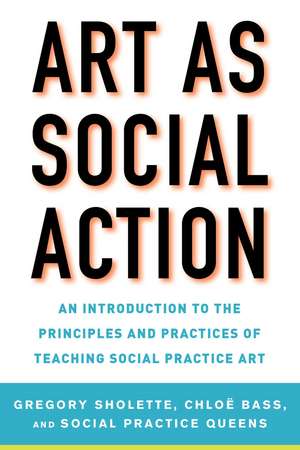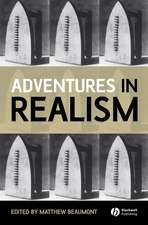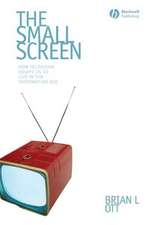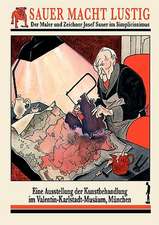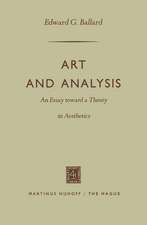Art as Social Action: An Introduction to the Principles and Practices of Teaching Social Practice Art
Editat de Gregory Sholette, Chloë Bass, Social Practice Queensen Limba Engleză Paperback – 22 mai 2018 – vârsta ani
Art as Social Action is both a general introduction to and an illustrated, practical textbook for the field of social practice, an art medium that has been gaining popularity in the public sphere. With content arranged thematically around such topics as direct action, alternative organizing, urban imaginaries, anti-bias work, and collective learning, among others, Art as Social Action is a comprehensive manual for teachers about how to teach art as social practice.
Along with a series of introductions by leading social practice artists in the field, valuable lesson plans offer examples of pedagogical projects for instructors at both college and high school levels with contributions written by prominent social practice artists, teachers, and thinkers, including:
- Mary Jane Jacob
- Maureen Connor
- Brian Rosa
- Pablo Helguera
- Jen de los Reyes
- Jeanne van Heeswick
- Jaishri Abichandani
- Loraine Leeson
- Ala Plastica
- Daniel Tucker
- Fiona Whelan
- Bo Zheng
- Dipti Desai
- Noah Fischer
Lesson plans also reflect the ongoing pedagogical and art action work of Social Practice Queens (SPQ), a unique partnership between Queens College CUNY and the Queens Museum.
Preț: 96.24 lei
Preț vechi: 165.09 lei
-42% Nou
Puncte Express: 144
Preț estimativ în valută:
18.42€ • 19.28$ • 15.24£
18.42€ • 19.28$ • 15.24£
Carte disponibilă
Livrare economică 21 martie-02 aprilie
Preluare comenzi: 021 569.72.76
Specificații
ISBN-13: 9781621535522
ISBN-10: 1621535525
Pagini: 336
Ilustrații: black-and-white illustrations
Dimensiuni: 152 x 229 x 28 mm
Greutate: 0.39 kg
Editura: Allworth
Colecția Allworth
ISBN-10: 1621535525
Pagini: 336
Ilustrații: black-and-white illustrations
Dimensiuni: 152 x 229 x 28 mm
Greutate: 0.39 kg
Editura: Allworth
Colecția Allworth
Notă biografică
Gregory Sholette is an artist, writer, and activist focused on excavating the history and theory of socially engaged art. His books include Delirium and Resistance: Activist Art and the Crisis of Capitalism and Dark Matter: Art and Politics in an Age of Enterprise Culture. He is a graduate of the Whitney Independent Studies Program, holds a PhD from the University of Amsterdam, and teaches Social Practice Queens, Queens College, CUNY, which he cofounded with Maureen Connor and the Queens Museum in 2010.
Chloë Bass is an artist and public practitioner focused on scales of interpersonal intimacy and daily life as a site of deep research. She is a regular contributor to Hyperallergic, where she writes about the urban environment, performance, social practice, and race. Her artistic work has been supported by many organizations, including the Laundromat Project, the Pulitzer Foundation, and Lower Manhattan Cultural Council. A graduate of Yale and Brooklyn College, she is an assistant professor of art, teaching in Social Practice Queens, Queens College, CUNY.
Chloë Bass is an artist and public practitioner focused on scales of interpersonal intimacy and daily life as a site of deep research. She is a regular contributor to Hyperallergic, where she writes about the urban environment, performance, social practice, and race. Her artistic work has been supported by many organizations, including the Laundromat Project, the Pulitzer Foundation, and Lower Manhattan Cultural Council. A graduate of Yale and Brooklyn College, she is an assistant professor of art, teaching in Social Practice Queens, Queens College, CUNY.
Recenzii
"Art as Social Action presents a sharp set of pedagogical tools for teaching and learning about art as a vehicle for social engagement. Having evolved from an innovative collaboration between Queens College and Queens Museum, the book's offerings are embedded in the workings of both community and artists, breaking down the very idea of what participation means in art and non-art contexts. Key questions of authorship, which audiences are served, how does engagement happen, and whose needs are met and how are addressed with forthright vigor. The volume importantly provides rigorous interrogation of the process as well as the outcomes; it is an essential guide to deepening social art practices and teaching them to students." —Laura Raicovich, president and executive director, Queens Museum, NYC
"It's no small thing to educate at the intersection of art and social justice. It's a scope of inquiry that has tripped up art historians, artists, and college deans for multiple decades. This contribution is valuable to educators in its insight, pragmatism, and breadth." —Nato Thompson, artistic director of Creative Time, author of Culture as a Weapon: The Art of Influence in Everyday Life
"As a curriculum resource, this book is most useful for artist-educators who are already doing and teaching socially engaged art. . . . Art as Social Action also provides a snapshot of the many ways in which socially engaged art practices overlap with social justice approaches to art education, particularly those that attend to power relationships between teachers, students, schools, and communities, and to the social structures that shape art education pedagogy." —Studies in Art Education: A Journal of Issues and Research
“I find Art as Social Action to be a workhorse of a book that is filled with a vast array of social practice projects, teaching strategies, and resources. . . . [T]his book opens up a much-needed conversation about issues that arise when teaching something that is, for the most part, always under development, in conflict with traditional ways of making art, and requires some serious shifts in thinking about the potential for art/pedagogy in contemporary contexts.” —Lynn Sanders-Bustle, Art/Research International: A Transdisciplinary Journal
"This book is a great resource that connects the dots between the pedagogy for socially engaged art and the most pressing pressure points for social change. In doing so, it reinforces the urgency of this art practice, and signals clearly that social practice prioritizes societal change over academicism." —Paul Ramirez Jonas, artist and professor, Hunter College CUNY
"Art as Social Action is a powerful testament to the resliience of artists and educators in keeping critical thinking and creative expression central to how we define ourselves as a people in the era of late capitalism. Chloë Bass and Gregory Sholette bookend this anthology of methodologies with their key wisdom on how, where, and why art and education blur into the social realm. Now more than ever there is a need to recognize the plurality of voices, approaches, and directions that socially engaged art practice offers. This book shows that the many-headed beast of social art practice cannot be defined singularly or sold in duplication. Any practitioner working with communities or any educator looking for strategies for engagement would benefit from the wealth of information in these pages." —R. M. Sánchez-Camus, PhD, Social Art Network, UK
"Art as Social Action is not your typical book about socially engaged art. . . . It is a collection of texts by teachers who, together with their art students, look for creative ways to enter in a discussion with society outside the classroom about topics as different as labour conditions, immigrant rights or mining on sacred Native American sites. Texts by teachers who want to make works with rather than about local communities. And, hopefully, make this world a slightly fairer and kinder one." —we make money not art (blog)
"Art as Social Action presents a sharp set of pedagogical tools for teaching and learning about art as a vehicle for social engagement. Having evolved from an innovative collaboration between Queens College and Queens Museum, the book's offerings are embedded in the workings of both community and artists, breaking down the very idea of what participation means in art and non-art contexts. Key questions of authorship, which audiences are served, how does engagement happen, and whose needs are met and how are addressed with forthright vigor. The volume importantly provides rigorous interrogation of the process as well as the outcomes; it is an essential guide to deepening social art practices and teaching them to students." —Laura Raicovich, president and executive director, Queens Museum, NYC
"It's no small thing to educate at the intersection of art and social justice. It's a scope of inquiry that has tripped up art historians, artists, and college deans for multiple decades. This contribution is valuable to educators in its insight, pragmatism, and breadth." —Nato Thompson, artistic director of Creative Time, author of Culture as a Weapon: The Art of Influence in Everyday Life
"This book is a great resource that connects the dots between the pedagogy for socially engaged art and the most pressing pressure points for social change. In doing so, it reinforces the urgency of this art practice, and signals clearly that social practice prioritizes societal change over academicism." —Paul Ramirez Jonas, artist and professor, Hunter College CUNY
"Art as Social Action is a powerful testament to the resliience of artists and educators in keeping critical thinking and creative expression central to how we define ourselves as a people in the era of late capitalism. Chloë Bass and Gregory Sholette bookend this anthology of methodologies with their key wisdom on how, where, and why art and education blur into the social realm. Now more than ever there is a need to recognize the plurality of voices, approaches, and directions that socially engaged art practice offers. This book shows that the many-headed beast of social art practice cannot be defined singularly or sold in duplication. Any practitioner working with communities or any educator looking for strategies for engagement would benefit from the wealth of information in these pages." —R. M. Sánchez-Camus, PhD, Social Art Network, UK
"Art as Social Action is not your typical book about socially engaged art. . . . It is a collection of texts by teachers who, together with their art students, look for creative ways to enter in a discussion with society outside the classroom about topics as different as labour conditions, immigrant rights or mining on sacred Native American sites. Texts by teachers who want to make works with rather than about local communities. And, hopefully, make this world a slightly fairer and kinder one." —we make money not art (blog)
"It's no small thing to educate at the intersection of art and social justice. It's a scope of inquiry that has tripped up art historians, artists, and college deans for multiple decades. This contribution is valuable to educators in its insight, pragmatism, and breadth." —Nato Thompson, artistic director of Creative Time, author of Culture as a Weapon: The Art of Influence in Everyday Life
"As a curriculum resource, this book is most useful for artist-educators who are already doing and teaching socially engaged art. . . . Art as Social Action also provides a snapshot of the many ways in which socially engaged art practices overlap with social justice approaches to art education, particularly those that attend to power relationships between teachers, students, schools, and communities, and to the social structures that shape art education pedagogy." —Studies in Art Education: A Journal of Issues and Research
“I find Art as Social Action to be a workhorse of a book that is filled with a vast array of social practice projects, teaching strategies, and resources. . . . [T]his book opens up a much-needed conversation about issues that arise when teaching something that is, for the most part, always under development, in conflict with traditional ways of making art, and requires some serious shifts in thinking about the potential for art/pedagogy in contemporary contexts.” —Lynn Sanders-Bustle, Art/Research International: A Transdisciplinary Journal
"This book is a great resource that connects the dots between the pedagogy for socially engaged art and the most pressing pressure points for social change. In doing so, it reinforces the urgency of this art practice, and signals clearly that social practice prioritizes societal change over academicism." —Paul Ramirez Jonas, artist and professor, Hunter College CUNY
"Art as Social Action is a powerful testament to the resliience of artists and educators in keeping critical thinking and creative expression central to how we define ourselves as a people in the era of late capitalism. Chloë Bass and Gregory Sholette bookend this anthology of methodologies with their key wisdom on how, where, and why art and education blur into the social realm. Now more than ever there is a need to recognize the plurality of voices, approaches, and directions that socially engaged art practice offers. This book shows that the many-headed beast of social art practice cannot be defined singularly or sold in duplication. Any practitioner working with communities or any educator looking for strategies for engagement would benefit from the wealth of information in these pages." —R. M. Sánchez-Camus, PhD, Social Art Network, UK
"Art as Social Action is not your typical book about socially engaged art. . . . It is a collection of texts by teachers who, together with their art students, look for creative ways to enter in a discussion with society outside the classroom about topics as different as labour conditions, immigrant rights or mining on sacred Native American sites. Texts by teachers who want to make works with rather than about local communities. And, hopefully, make this world a slightly fairer and kinder one." —we make money not art (blog)
"Art as Social Action presents a sharp set of pedagogical tools for teaching and learning about art as a vehicle for social engagement. Having evolved from an innovative collaboration between Queens College and Queens Museum, the book's offerings are embedded in the workings of both community and artists, breaking down the very idea of what participation means in art and non-art contexts. Key questions of authorship, which audiences are served, how does engagement happen, and whose needs are met and how are addressed with forthright vigor. The volume importantly provides rigorous interrogation of the process as well as the outcomes; it is an essential guide to deepening social art practices and teaching them to students." —Laura Raicovich, president and executive director, Queens Museum, NYC
"It's no small thing to educate at the intersection of art and social justice. It's a scope of inquiry that has tripped up art historians, artists, and college deans for multiple decades. This contribution is valuable to educators in its insight, pragmatism, and breadth." —Nato Thompson, artistic director of Creative Time, author of Culture as a Weapon: The Art of Influence in Everyday Life
"This book is a great resource that connects the dots between the pedagogy for socially engaged art and the most pressing pressure points for social change. In doing so, it reinforces the urgency of this art practice, and signals clearly that social practice prioritizes societal change over academicism." —Paul Ramirez Jonas, artist and professor, Hunter College CUNY
"Art as Social Action is a powerful testament to the resliience of artists and educators in keeping critical thinking and creative expression central to how we define ourselves as a people in the era of late capitalism. Chloë Bass and Gregory Sholette bookend this anthology of methodologies with their key wisdom on how, where, and why art and education blur into the social realm. Now more than ever there is a need to recognize the plurality of voices, approaches, and directions that socially engaged art practice offers. This book shows that the many-headed beast of social art practice cannot be defined singularly or sold in duplication. Any practitioner working with communities or any educator looking for strategies for engagement would benefit from the wealth of information in these pages." —R. M. Sánchez-Camus, PhD, Social Art Network, UK
"Art as Social Action is not your typical book about socially engaged art. . . . It is a collection of texts by teachers who, together with their art students, look for creative ways to enter in a discussion with society outside the classroom about topics as different as labour conditions, immigrant rights or mining on sacred Native American sites. Texts by teachers who want to make works with rather than about local communities. And, hopefully, make this world a slightly fairer and kinder one." —we make money not art (blog)
